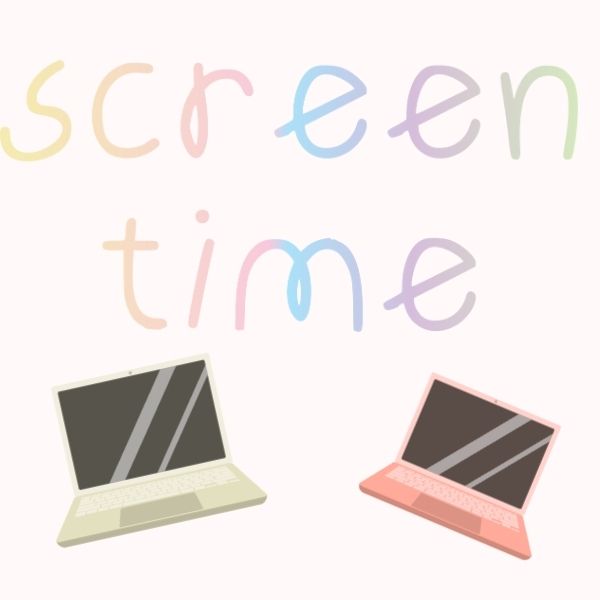Raising our littles in our increasingly tech-saturated world brings with it another set of challenges that can be tricky to navigate. This is a tough subject to address and to write about because the truth is, there are mixed messages and difficult to define conditions surrounding screen time, which makes it a little bit gray. Plus, even if we know the recommendations, our daily life makes it so hard to limit and our world is increasingly technology-dependent. As a parent, navigating how much screen time to allow, understanding the information about what the research teaches us, and finding a balance that works for your family can be a unique challenge. The purpose of this post is simply to provide information so that you can make the absolute best decisions for your family, without feeling judged, this includes being too hard on yourself!
We will talk a little bit about what the research does (and does not) tell us, as well as some things that will help you consider the unique temperament and needs of your little and your family to help you make the best possible decision. But here is the key- and the thing that makes it tricky to give advice- it truly is all about making the decision that is best for your family. Life will continue to ‘life’ and sometimes we cannot realistically follow all of the guidelines and advice to a “T”….but like most things in life, we can make the best adaptations and decisions for our littles and our family when we know all of the information. Please note that this blog post is not a substitution for the advice of your pediatrician- each child is unique and has unique needs that often cause adjustments to these recommendations. Please always ask your pediatrician, specialist (SLP, OT, PT), and other professionals working on your child’s team to make the best decisions for you. On that note, here’s to diving into some of the information that is available to us regarding screen time!
What the Research Tells Us- Screen Time & Language Development
So, what’s the scoop on screen time and language development? Well, the experts have weighed in and, as with most things, there is a ton of information out there and it can be tricky to distill. Let’s highlight some of the information with the understanding that the experts continue to research and adapt the guidelines as we learn more! As of right now, studies do suggest that too much screen time can put the brakes on language development, especially for our littles under the age of 2. In 2007, another study (2) looked at language development in littles under 2 years old and the study indicated that littles aged 8-16 months who watched more videos said fewer words, whereas there was not an association between words and videos watched in 17-24 month olds. The study indicated that additional research is needed in order to determine specific associations between language development and videos. A review of the research conducted in 2022 (3) indicated that introducing screen time at early ages had negative effects on language development, whereas introducing screen time at an older age showed some benefits. Video content, characteristics, and presence of co-viewing had an influence on language development (another words, all screen time is not created equally!) This study, again, noted that additional research is needed, but that the negatives of screen time did appear to outweigh the positives, but both negatives and positives were uncovered (again, more research is needed here!).
That critical period between 0-18 months is when our littles’ brains are like literal language-learning machines. They are soaking in information at incredible rates and are mapping that information to form the foundation for language that they will use for the rest of their lives!! They’re not getting their best lessons from screens, they need to hear and process us fellow humans. They pick up language skills from actual, back-and-forth, eye-to-eye human interaction and need those moments of joint attention (attending to the same thing at the same time) to develop cognitive, social, and linguistic skills that will pave the way for their learning in the years to come.
A meta-analysis(1) (this is a type of study where researchers look into all of the research available and draw conclusions from the commonalities) that was completed in 2020 showed us that there is a correlation between screen time and language development- both in quantity and quality! More screen time had worse effects of language development (more screen time=less conducive to language). In addition, this study showed us that the type of screen time matters! Programs and media that are educational in nature or co-viewed (mommy and baby are watching together and interacting around the content) had better impacts on language development. Another study conducted in 2023 highlighted that higher amounts of screen time watched per age group was associated with later delays in communication and problem solving in children ages 2-4. (4)

This research aligns with the American Academy of Pediatrics (AAP). They recommend eliminating or, at best, minimizing screen time/media exposure for littles that are under the age of 18, the exception to this is when using media for video chatting or communication purposes. For older preschool-aged kiddos, providing limited time frames for screen time as well as monitoring the type of media that the littles are exposed to is recommended.
- For our 18-24 month olds, the AAP recommends choosing high-quality content and co-viewing it to encourage interactions around the information and help them to bridge their understanding to how it connects to the world.
- The AAP recommends no more than one hour per day for our kiddos over two years old, with high-quality content and co-viewing when possible.
- The AAP also recommends that screens not be utilized during meals or one hour before bedtime; a major caveat here is that some kiddos and families with diverse needs may need to adjust these expectations and these are not definitive rules to live by- they are just guidelines that should be adjusted and adapted for your own family, because there may be some benefits to quality screen time as well!! There is more research that needs to be done, as the current studies all show correlation, but not causation. The information we have is strong enough to help us make educated choices about putting limitations on screen time and picking higher quality information for our kiddos to watch, but we still need to stay tuned for more conclusive information to be coming out in the future! So, it’s not necessarily about banning screens, but using them wisely and considering the developmental stage that your child is in to help you figure out what those boundaries might be for you and your family.
All Screen Time Is Not Created Equally: Different Types of Screen Time for Children
Okay, now that we got that out of the way (phewph!) It’s time to chat about the variety of screen time available for your little ones. Believe it or not, screen time is not created equally! Let’s talk about some different scenarios….
- Passive Screen Time: Your little is plopped on the couch watching their favorite TV show, completely entranced by the screen. In this case, they are just passively consuming content- this is passive screen time.
- Interactive Screen Time: Your little is playing a game and interacting with the pieces to somehow engage with the game. This may even be a video game that teaches them skills or asks them to use critical thinking skills. This is called interactive screen time!
- Facilitated Screen Time: This is where we hear the word ‘co-viewing’, where Mommy & baby are both sitting together while they are watching or interacting with the content. In this case, the adult can extend the activity by asking questions, modeling important words, and bridging the information to life in a more practical way.
- Educational Screen Time: This type of screen time is when computers, iPads, and other sources of technology are used for educational purposes like completing homework or learning!
- Social Screen Time: this type of screen time is when littles are engaged in video calls or virtual interactions with family and peers. This type of screen time can promote skills and connections.

The Quality of Screen Time Matters
So It’s not always about how much time our littles are spending in front of the screen, it’s also about what’s on that screen that they are attending to. Whenever possible, try to look for screen time that is educational and interactive by prompting your little to think about, comment on, and/or participate with the content. If you can be there to extend the information to the real world and provide that real-person prompting/interaction for them, that’s an even better bonus. We also want to think about the level of complexity and make sure that it is appropriate. It’s best to make sure that the information is age-appropriate because too complex or not complex enough can lead to frustration. We can look for screen activities that bridge nicely into the real world: think songs that they can sing along with, stories that they can act out or retell, games that they can play in the real world, or vocabulary that they can map to their little world. This way, their time with the screen is helping them to learn about their real world and create that connection.
With All That Said….In Comes Reality!! Creating a Balanced Screen Time Schedule
Alright, let’s dive into crafting a schedule that keeps screen time in check. Start by thinking about some rules that you want to create around screen time. These rules can include type of screen time, limitations about the content, and how much screen time usage as well as times of the day where screen time is not an option. You can also take the approach of thinking about different types of activities that you want your little one to engage in throughout the day. Some of these activities might be gross motor play, outdoor time, crafts or creativity time, fine motor play, family time, and day-to-day routines. If you can think about how much of your day you ideally want your little one to be engaged in each of these tasks, then you can find a way to fit educational screen time or interactive screen time into that balanced schedule. The AAP has a great resource to help you come up with a Family Media Plan, even for older kiddos, that helps families to discuss safety, practicality, and appropriate content for each member of the family.
The Bottom Line
There is no perfect schedule or one recommendation that will be followed to a T. A few minutes of screen time so that you can warm up your coffee or sit for a minute will not cause irreparable harm to your little one. Be aware of the research and understand the recommendations, consult with your pediatrician and other professionals, and then come back to your own personal circumstances and the needs of your family. Make informed decisions that work for your life and your families, you are doing a GREAT job!
Disclaimer: By using this website, you agree to the terms and conditions listed here. The information on this blog post should not be used as a substitute for the medical care and advice of your pediatrician. Please consult your pediatrician for recommendations based on individual circumstances and always ensure that you are monitoring websites, information, interactions etc. for safety and appropriateness. The information in this blog post is not all-inclusive and does not touch upon all of the information available in order to ensure safety and appropriate content- please note that the information in this article is the opinion of the author and the author alone and does not constitute professional advice or a treatment plan. The author hereby disclaims any liability. Please see our full terms of use for more information about liability, policies, limitations, accuracy, rights, and more.







